Ecology and Sustainability: Analysis of Invasive Species & Tree Health
VerifiedAdded on 2023/06/11
|12
|3211
|299
Essay
AI Summary
This essay delves into the critical issues of ecology and sustainability, focusing on the detrimental impacts of invasive species, pests, and pathogens on tree health and forest ecosystems. It identifies various causes of tree diseases, including fungal infections like Dutch elm disease and sudden oak death, as well as the introduction of invasive species such as flatworms and insects like the Asian longhorn beetle and cypress aphid. The essay further explores the ecological and economic consequences of these tree diseases, highlighting the costs associated with control research, pesticide use, and the loss of valuable timber resources. It emphasizes the urgent need for effective management strategies to mitigate the spread of these destructive organisms and protect forest biodiversity and economic stability. This resource is available for students on Desklib, offering a comprehensive overview of the challenges and potential solutions in preserving tree health and promoting ecological sustainability.
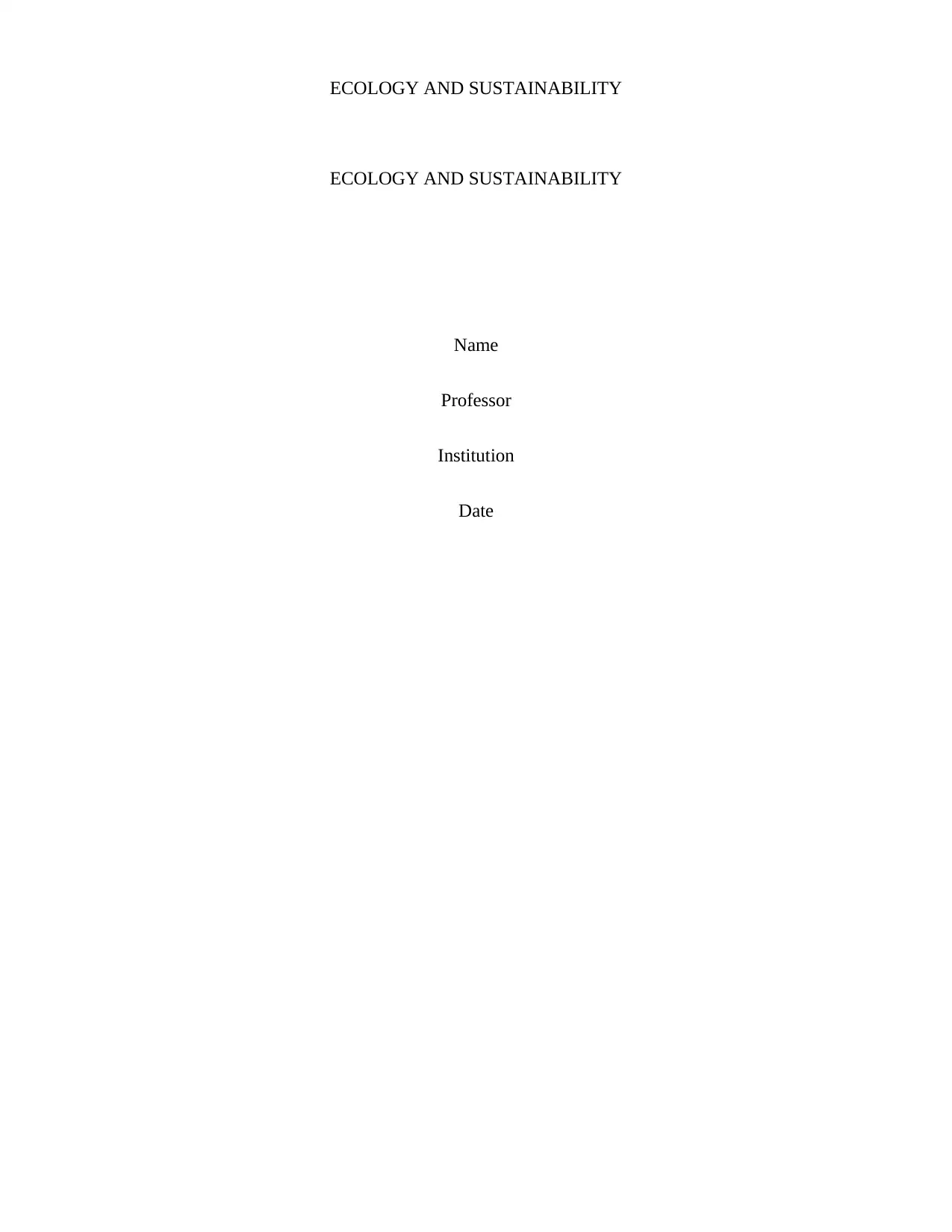
ECOLOGY AND SUSTAINABILITY
ECOLOGY AND SUSTAINABILITY
Name
Professor
Institution
Date
ECOLOGY AND SUSTAINABILITY
Name
Professor
Institution
Date
Paraphrase This Document
Need a fresh take? Get an instant paraphrase of this document with our AI Paraphraser
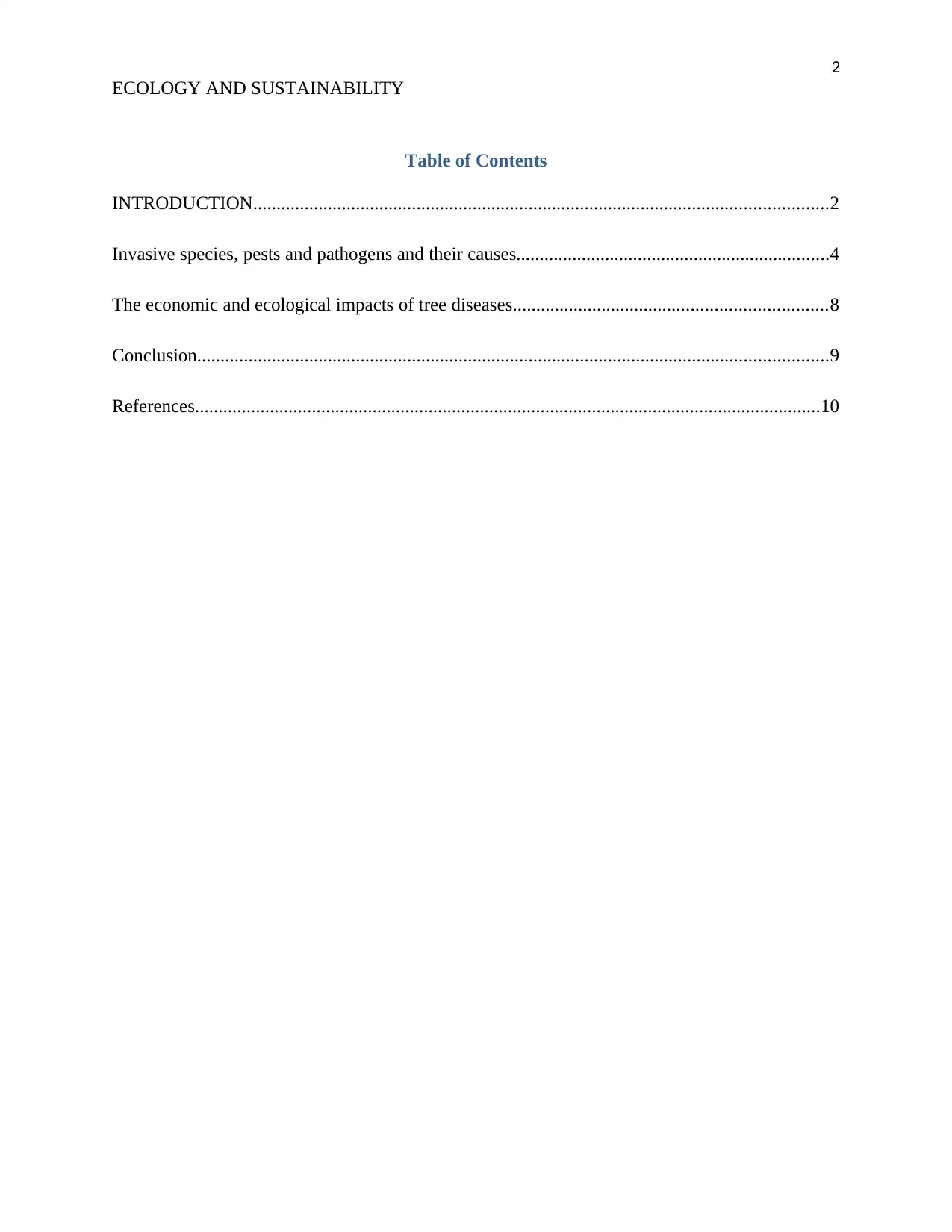
2
ECOLOGY AND SUSTAINABILITY
Table of Contents
INTRODUCTION...........................................................................................................................2
Invasive species, pests and pathogens and their causes...................................................................4
The economic and ecological impacts of tree diseases...................................................................8
Conclusion.......................................................................................................................................9
References......................................................................................................................................10
ECOLOGY AND SUSTAINABILITY
Table of Contents
INTRODUCTION...........................................................................................................................2
Invasive species, pests and pathogens and their causes...................................................................4
The economic and ecological impacts of tree diseases...................................................................8
Conclusion.......................................................................................................................................9
References......................................................................................................................................10
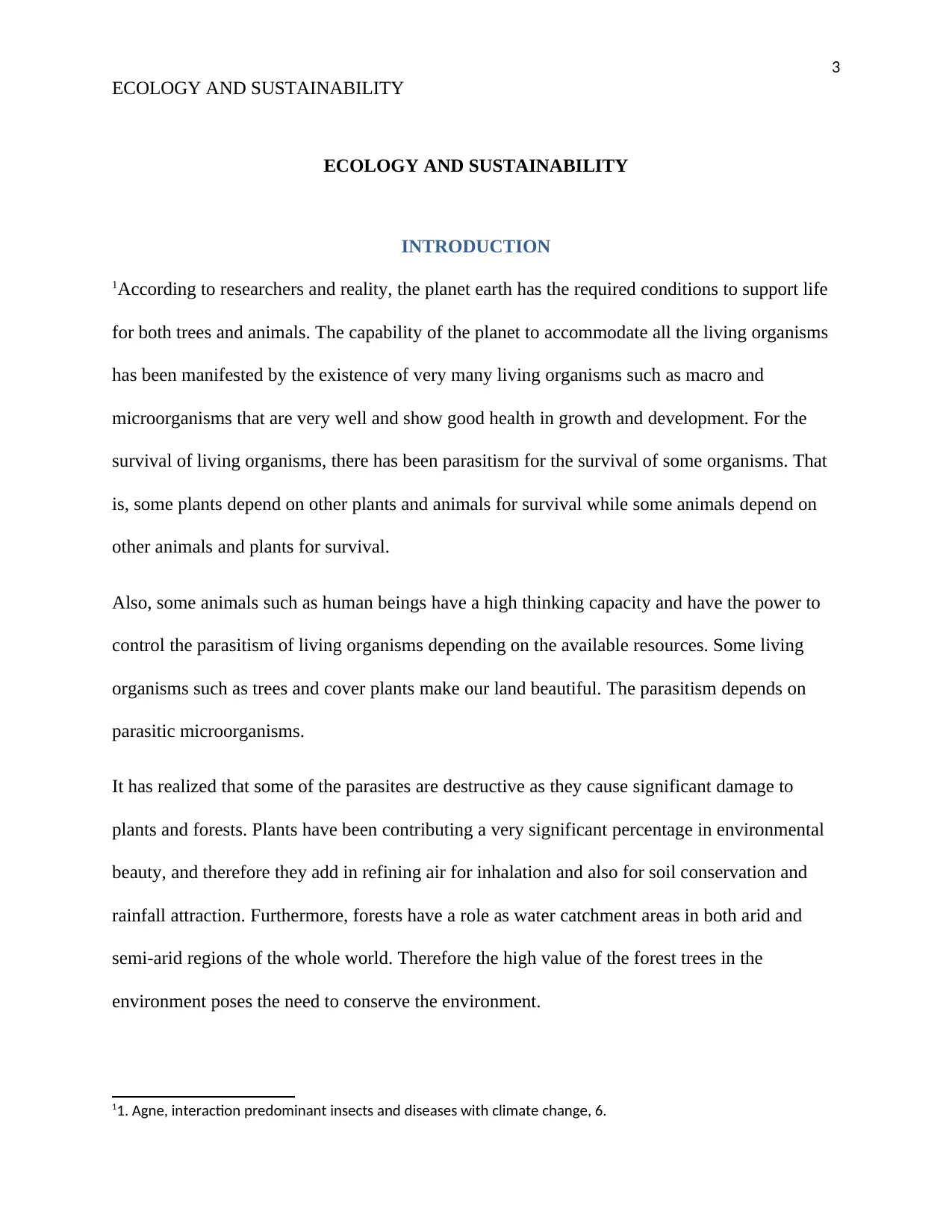
3
ECOLOGY AND SUSTAINABILITY
ECOLOGY AND SUSTAINABILITY
INTRODUCTION
1According to researchers and reality, the planet earth has the required conditions to support life
for both trees and animals. The capability of the planet to accommodate all the living organisms
has been manifested by the existence of very many living organisms such as macro and
microorganisms that are very well and show good health in growth and development. For the
survival of living organisms, there has been parasitism for the survival of some organisms. That
is, some plants depend on other plants and animals for survival while some animals depend on
other animals and plants for survival.
Also, some animals such as human beings have a high thinking capacity and have the power to
control the parasitism of living organisms depending on the available resources. Some living
organisms such as trees and cover plants make our land beautiful. The parasitism depends on
parasitic microorganisms.
It has realized that some of the parasites are destructive as they cause significant damage to
plants and forests. Plants have been contributing a very significant percentage in environmental
beauty, and therefore they add in refining air for inhalation and also for soil conservation and
rainfall attraction. Furthermore, forests have a role as water catchment areas in both arid and
semi-arid regions of the whole world. Therefore the high value of the forest trees in the
environment poses the need to conserve the environment.
11. Agne, interaction predominant insects and diseases with climate change, 6.
ECOLOGY AND SUSTAINABILITY
ECOLOGY AND SUSTAINABILITY
INTRODUCTION
1According to researchers and reality, the planet earth has the required conditions to support life
for both trees and animals. The capability of the planet to accommodate all the living organisms
has been manifested by the existence of very many living organisms such as macro and
microorganisms that are very well and show good health in growth and development. For the
survival of living organisms, there has been parasitism for the survival of some organisms. That
is, some plants depend on other plants and animals for survival while some animals depend on
other animals and plants for survival.
Also, some animals such as human beings have a high thinking capacity and have the power to
control the parasitism of living organisms depending on the available resources. Some living
organisms such as trees and cover plants make our land beautiful. The parasitism depends on
parasitic microorganisms.
It has realized that some of the parasites are destructive as they cause significant damage to
plants and forests. Plants have been contributing a very significant percentage in environmental
beauty, and therefore they add in refining air for inhalation and also for soil conservation and
rainfall attraction. Furthermore, forests have a role as water catchment areas in both arid and
semi-arid regions of the whole world. Therefore the high value of the forest trees in the
environment poses the need to conserve the environment.
11. Agne, interaction predominant insects and diseases with climate change, 6.
⊘ This is a preview!⊘
Do you want full access?
Subscribe today to unlock all pages.

Trusted by 1+ million students worldwide
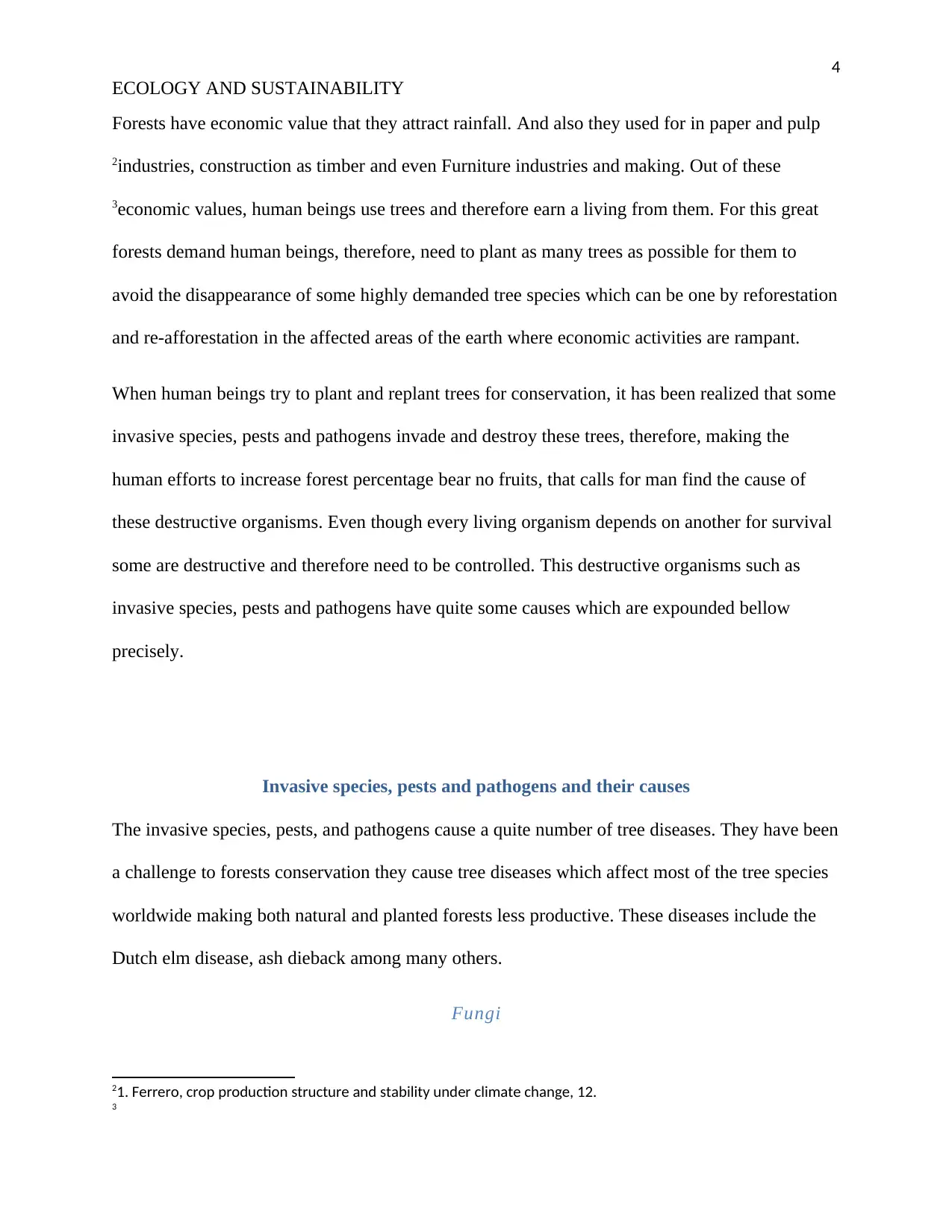
4
ECOLOGY AND SUSTAINABILITY
Forests have economic value that they attract rainfall. And also they used for in paper and pulp
2industries, construction as timber and even Furniture industries and making. Out of these
3economic values, human beings use trees and therefore earn a living from them. For this great
forests demand human beings, therefore, need to plant as many trees as possible for them to
avoid the disappearance of some highly demanded tree species which can be one by reforestation
and re-afforestation in the affected areas of the earth where economic activities are rampant.
When human beings try to plant and replant trees for conservation, it has been realized that some
invasive species, pests and pathogens invade and destroy these trees, therefore, making the
human efforts to increase forest percentage bear no fruits, that calls for man find the cause of
these destructive organisms. Even though every living organism depends on another for survival
some are destructive and therefore need to be controlled. This destructive organisms such as
invasive species, pests and pathogens have quite some causes which are expounded bellow
precisely.
Invasive species, pests and pathogens and their causes
The invasive species, pests, and pathogens cause a quite number of tree diseases. They have been
a challenge to forests conservation they cause tree diseases which affect most of the tree species
worldwide making both natural and planted forests less productive. These diseases include the
Dutch elm disease, ash dieback among many others.
Fungi
21. Ferrero, crop production structure and stability under climate change, 12.
3
ECOLOGY AND SUSTAINABILITY
Forests have economic value that they attract rainfall. And also they used for in paper and pulp
2industries, construction as timber and even Furniture industries and making. Out of these
3economic values, human beings use trees and therefore earn a living from them. For this great
forests demand human beings, therefore, need to plant as many trees as possible for them to
avoid the disappearance of some highly demanded tree species which can be one by reforestation
and re-afforestation in the affected areas of the earth where economic activities are rampant.
When human beings try to plant and replant trees for conservation, it has been realized that some
invasive species, pests and pathogens invade and destroy these trees, therefore, making the
human efforts to increase forest percentage bear no fruits, that calls for man find the cause of
these destructive organisms. Even though every living organism depends on another for survival
some are destructive and therefore need to be controlled. This destructive organisms such as
invasive species, pests and pathogens have quite some causes which are expounded bellow
precisely.
Invasive species, pests and pathogens and their causes
The invasive species, pests, and pathogens cause a quite number of tree diseases. They have been
a challenge to forests conservation they cause tree diseases which affect most of the tree species
worldwide making both natural and planted forests less productive. These diseases include the
Dutch elm disease, ash dieback among many others.
Fungi
21. Ferrero, crop production structure and stability under climate change, 12.
3
Paraphrase This Document
Need a fresh take? Get an instant paraphrase of this document with our AI Paraphraser
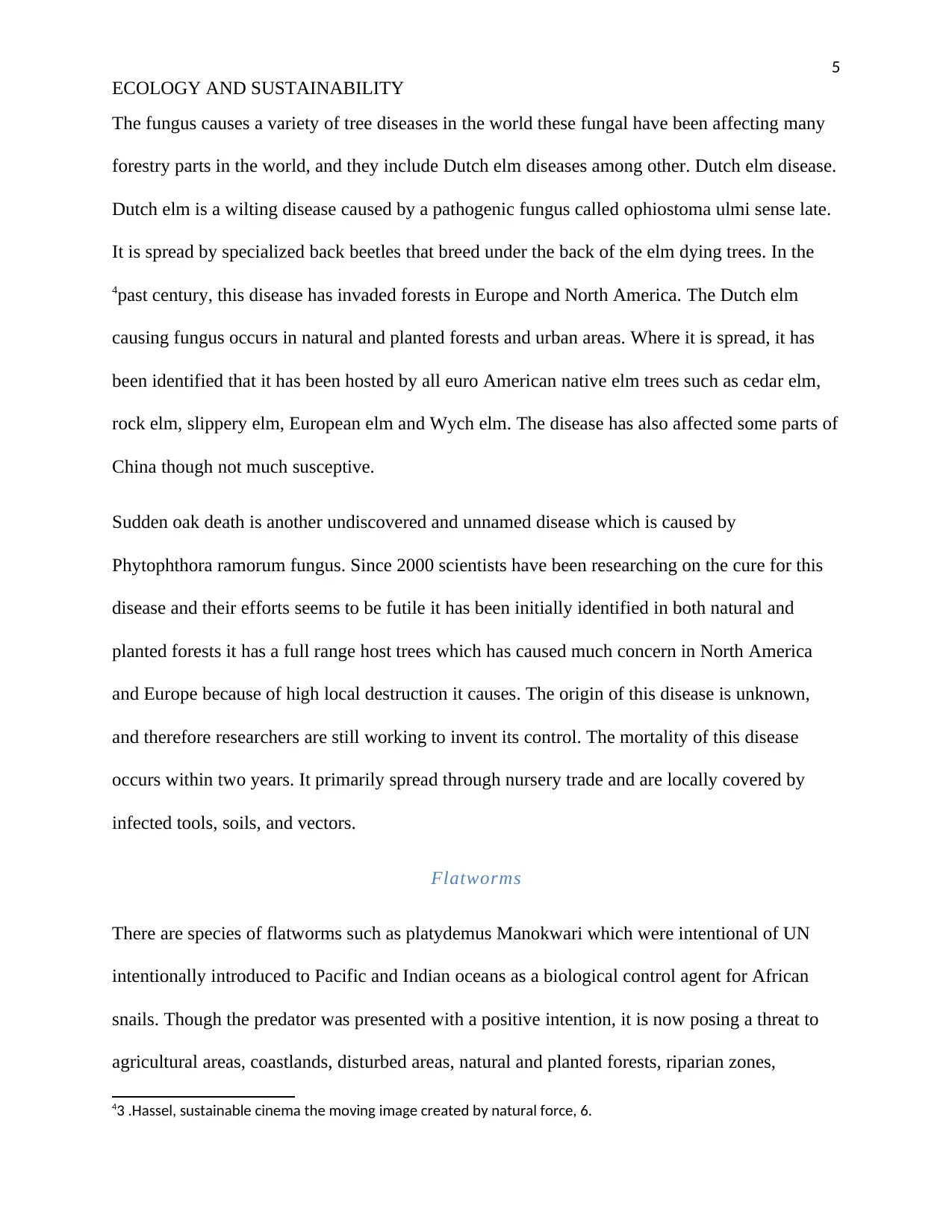
5
ECOLOGY AND SUSTAINABILITY
The fungus causes a variety of tree diseases in the world these fungal have been affecting many
forestry parts in the world, and they include Dutch elm diseases among other. Dutch elm disease.
Dutch elm is a wilting disease caused by a pathogenic fungus called ophiostoma ulmi sense late.
It is spread by specialized back beetles that breed under the back of the elm dying trees. In the
4past century, this disease has invaded forests in Europe and North America. The Dutch elm
causing fungus occurs in natural and planted forests and urban areas. Where it is spread, it has
been identified that it has been hosted by all euro American native elm trees such as cedar elm,
rock elm, slippery elm, European elm and Wych elm. The disease has also affected some parts of
China though not much susceptive.
Sudden oak death is another undiscovered and unnamed disease which is caused by
Phytophthora ramorum fungus. Since 2000 scientists have been researching on the cure for this
disease and their efforts seems to be futile it has been initially identified in both natural and
planted forests it has a full range host trees which has caused much concern in North America
and Europe because of high local destruction it causes. The origin of this disease is unknown,
and therefore researchers are still working to invent its control. The mortality of this disease
occurs within two years. It primarily spread through nursery trade and are locally covered by
infected tools, soils, and vectors.
Flatworms
There are species of flatworms such as platydemus Manokwari which were intentional of UN
intentionally introduced to Pacific and Indian oceans as a biological control agent for African
snails. Though the predator was presented with a positive intention, it is now posing a threat to
agricultural areas, coastlands, disturbed areas, natural and planted forests, riparian zones,
43 .Hassel, sustainable cinema the moving image created by natural force, 6.
ECOLOGY AND SUSTAINABILITY
The fungus causes a variety of tree diseases in the world these fungal have been affecting many
forestry parts in the world, and they include Dutch elm diseases among other. Dutch elm disease.
Dutch elm is a wilting disease caused by a pathogenic fungus called ophiostoma ulmi sense late.
It is spread by specialized back beetles that breed under the back of the elm dying trees. In the
4past century, this disease has invaded forests in Europe and North America. The Dutch elm
causing fungus occurs in natural and planted forests and urban areas. Where it is spread, it has
been identified that it has been hosted by all euro American native elm trees such as cedar elm,
rock elm, slippery elm, European elm and Wych elm. The disease has also affected some parts of
China though not much susceptive.
Sudden oak death is another undiscovered and unnamed disease which is caused by
Phytophthora ramorum fungus. Since 2000 scientists have been researching on the cure for this
disease and their efforts seems to be futile it has been initially identified in both natural and
planted forests it has a full range host trees which has caused much concern in North America
and Europe because of high local destruction it causes. The origin of this disease is unknown,
and therefore researchers are still working to invent its control. The mortality of this disease
occurs within two years. It primarily spread through nursery trade and are locally covered by
infected tools, soils, and vectors.
Flatworms
There are species of flatworms such as platydemus Manokwari which were intentional of UN
intentionally introduced to Pacific and Indian oceans as a biological control agent for African
snails. Though the predator was presented with a positive intention, it is now posing a threat to
agricultural areas, coastlands, disturbed areas, natural and planted forests, riparian zones,
43 .Hassel, sustainable cinema the moving image created by natural force, 6.
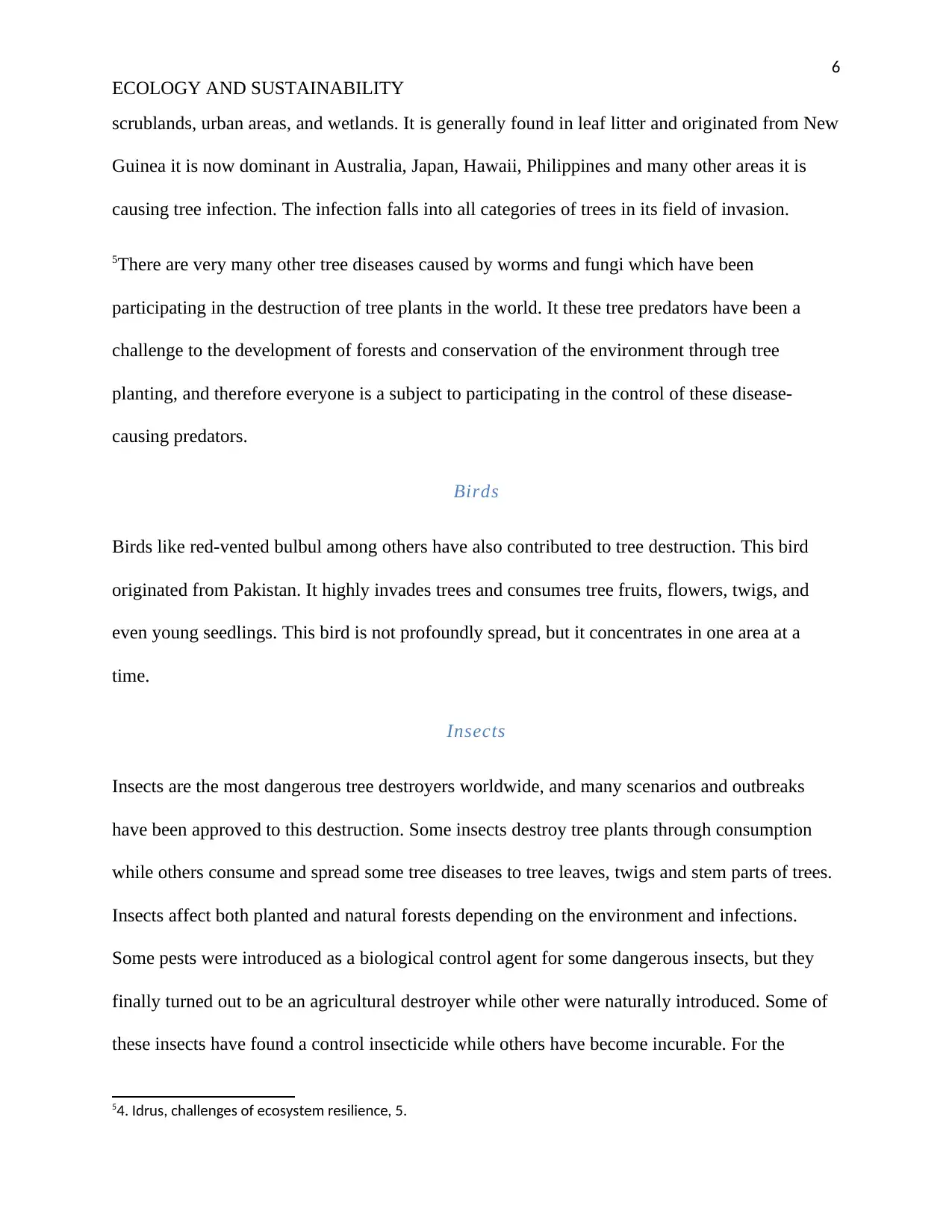
6
ECOLOGY AND SUSTAINABILITY
scrublands, urban areas, and wetlands. It is generally found in leaf litter and originated from New
Guinea it is now dominant in Australia, Japan, Hawaii, Philippines and many other areas it is
causing tree infection. The infection falls into all categories of trees in its field of invasion.
5There are very many other tree diseases caused by worms and fungi which have been
participating in the destruction of tree plants in the world. It these tree predators have been a
challenge to the development of forests and conservation of the environment through tree
planting, and therefore everyone is a subject to participating in the control of these disease-
causing predators.
Birds
Birds like red-vented bulbul among others have also contributed to tree destruction. This bird
originated from Pakistan. It highly invades trees and consumes tree fruits, flowers, twigs, and
even young seedlings. This bird is not profoundly spread, but it concentrates in one area at a
time.
Insects
Insects are the most dangerous tree destroyers worldwide, and many scenarios and outbreaks
have been approved to this destruction. Some insects destroy tree plants through consumption
while others consume and spread some tree diseases to tree leaves, twigs and stem parts of trees.
Insects affect both planted and natural forests depending on the environment and infections.
Some pests were introduced as a biological control agent for some dangerous insects, but they
finally turned out to be an agricultural destroyer while other were naturally introduced. Some of
these insects have found a control insecticide while others have become incurable. For the
54. Idrus, challenges of ecosystem resilience, 5.
ECOLOGY AND SUSTAINABILITY
scrublands, urban areas, and wetlands. It is generally found in leaf litter and originated from New
Guinea it is now dominant in Australia, Japan, Hawaii, Philippines and many other areas it is
causing tree infection. The infection falls into all categories of trees in its field of invasion.
5There are very many other tree diseases caused by worms and fungi which have been
participating in the destruction of tree plants in the world. It these tree predators have been a
challenge to the development of forests and conservation of the environment through tree
planting, and therefore everyone is a subject to participating in the control of these disease-
causing predators.
Birds
Birds like red-vented bulbul among others have also contributed to tree destruction. This bird
originated from Pakistan. It highly invades trees and consumes tree fruits, flowers, twigs, and
even young seedlings. This bird is not profoundly spread, but it concentrates in one area at a
time.
Insects
Insects are the most dangerous tree destroyers worldwide, and many scenarios and outbreaks
have been approved to this destruction. Some insects destroy tree plants through consumption
while others consume and spread some tree diseases to tree leaves, twigs and stem parts of trees.
Insects affect both planted and natural forests depending on the environment and infections.
Some pests were introduced as a biological control agent for some dangerous insects, but they
finally turned out to be an agricultural destroyer while other were naturally introduced. Some of
these insects have found a control insecticide while others have become incurable. For the
54. Idrus, challenges of ecosystem resilience, 5.
⊘ This is a preview!⊘
Do you want full access?
Subscribe today to unlock all pages.

Trusted by 1+ million students worldwide
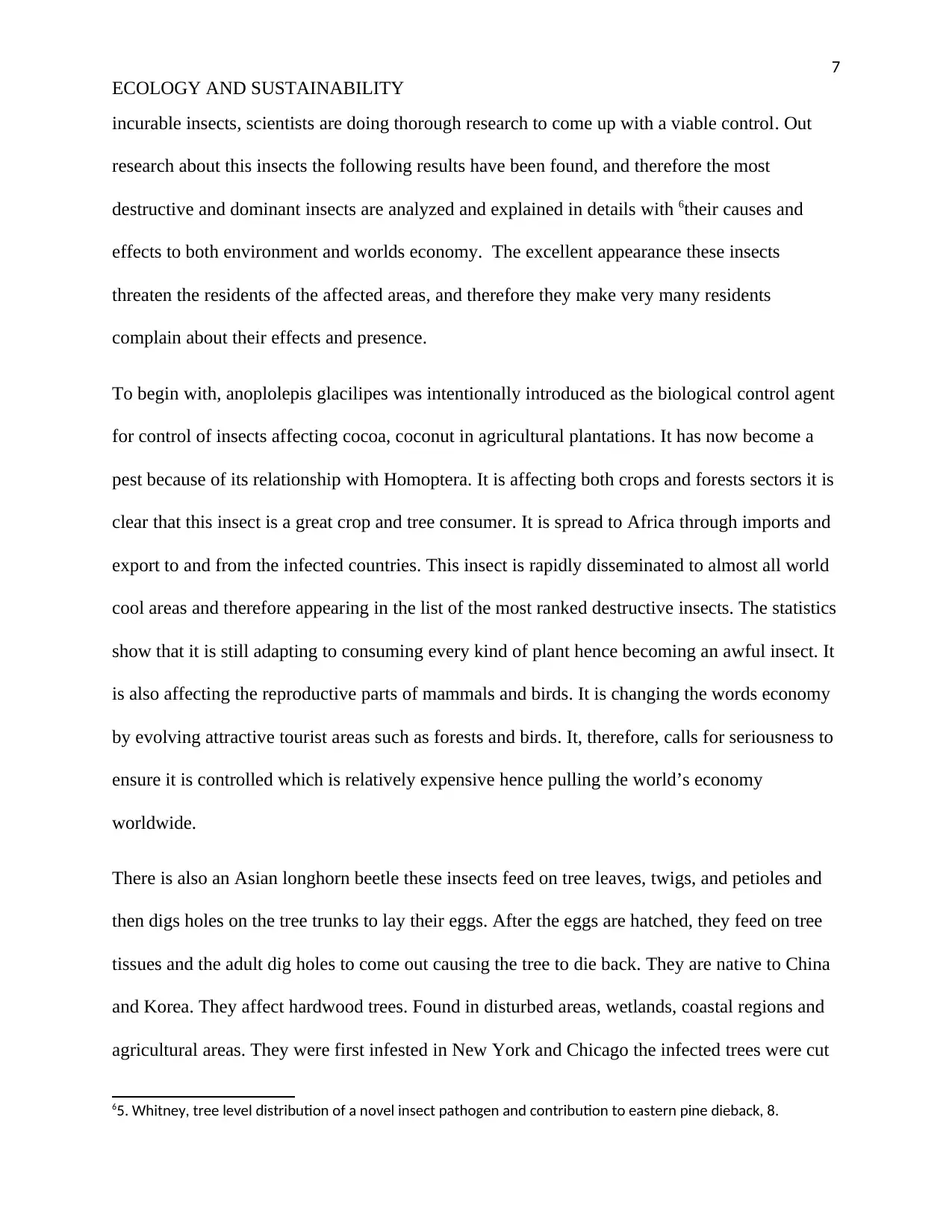
7
ECOLOGY AND SUSTAINABILITY
incurable insects, scientists are doing thorough research to come up with a viable control. Out
research about this insects the following results have been found, and therefore the most
destructive and dominant insects are analyzed and explained in details with 6their causes and
effects to both environment and worlds economy. The excellent appearance these insects
threaten the residents of the affected areas, and therefore they make very many residents
complain about their effects and presence.
To begin with, anoplolepis glacilipes was intentionally introduced as the biological control agent
for control of insects affecting cocoa, coconut in agricultural plantations. It has now become a
pest because of its relationship with Homoptera. It is affecting both crops and forests sectors it is
clear that this insect is a great crop and tree consumer. It is spread to Africa through imports and
export to and from the infected countries. This insect is rapidly disseminated to almost all world
cool areas and therefore appearing in the list of the most ranked destructive insects. The statistics
show that it is still adapting to consuming every kind of plant hence becoming an awful insect. It
is also affecting the reproductive parts of mammals and birds. It is changing the words economy
by evolving attractive tourist areas such as forests and birds. It, therefore, calls for seriousness to
ensure it is controlled which is relatively expensive hence pulling the world’s economy
worldwide.
There is also an Asian longhorn beetle these insects feed on tree leaves, twigs, and petioles and
then digs holes on the tree trunks to lay their eggs. After the eggs are hatched, they feed on tree
tissues and the adult dig holes to come out causing the tree to die back. They are native to China
and Korea. They affect hardwood trees. Found in disturbed areas, wetlands, coastal regions and
agricultural areas. They were first infested in New York and Chicago the infected trees were cut
65. Whitney, tree level distribution of a novel insect pathogen and contribution to eastern pine dieback, 8.
ECOLOGY AND SUSTAINABILITY
incurable insects, scientists are doing thorough research to come up with a viable control. Out
research about this insects the following results have been found, and therefore the most
destructive and dominant insects are analyzed and explained in details with 6their causes and
effects to both environment and worlds economy. The excellent appearance these insects
threaten the residents of the affected areas, and therefore they make very many residents
complain about their effects and presence.
To begin with, anoplolepis glacilipes was intentionally introduced as the biological control agent
for control of insects affecting cocoa, coconut in agricultural plantations. It has now become a
pest because of its relationship with Homoptera. It is affecting both crops and forests sectors it is
clear that this insect is a great crop and tree consumer. It is spread to Africa through imports and
export to and from the infected countries. This insect is rapidly disseminated to almost all world
cool areas and therefore appearing in the list of the most ranked destructive insects. The statistics
show that it is still adapting to consuming every kind of plant hence becoming an awful insect. It
is also affecting the reproductive parts of mammals and birds. It is changing the words economy
by evolving attractive tourist areas such as forests and birds. It, therefore, calls for seriousness to
ensure it is controlled which is relatively expensive hence pulling the world’s economy
worldwide.
There is also an Asian longhorn beetle these insects feed on tree leaves, twigs, and petioles and
then digs holes on the tree trunks to lay their eggs. After the eggs are hatched, they feed on tree
tissues and the adult dig holes to come out causing the tree to die back. They are native to China
and Korea. They affect hardwood trees. Found in disturbed areas, wetlands, coastal regions and
agricultural areas. They were first infested in New York and Chicago the infected trees were cut
65. Whitney, tree level distribution of a novel insect pathogen and contribution to eastern pine dieback, 8.
Paraphrase This Document
Need a fresh take? Get an instant paraphrase of this document with our AI Paraphraser
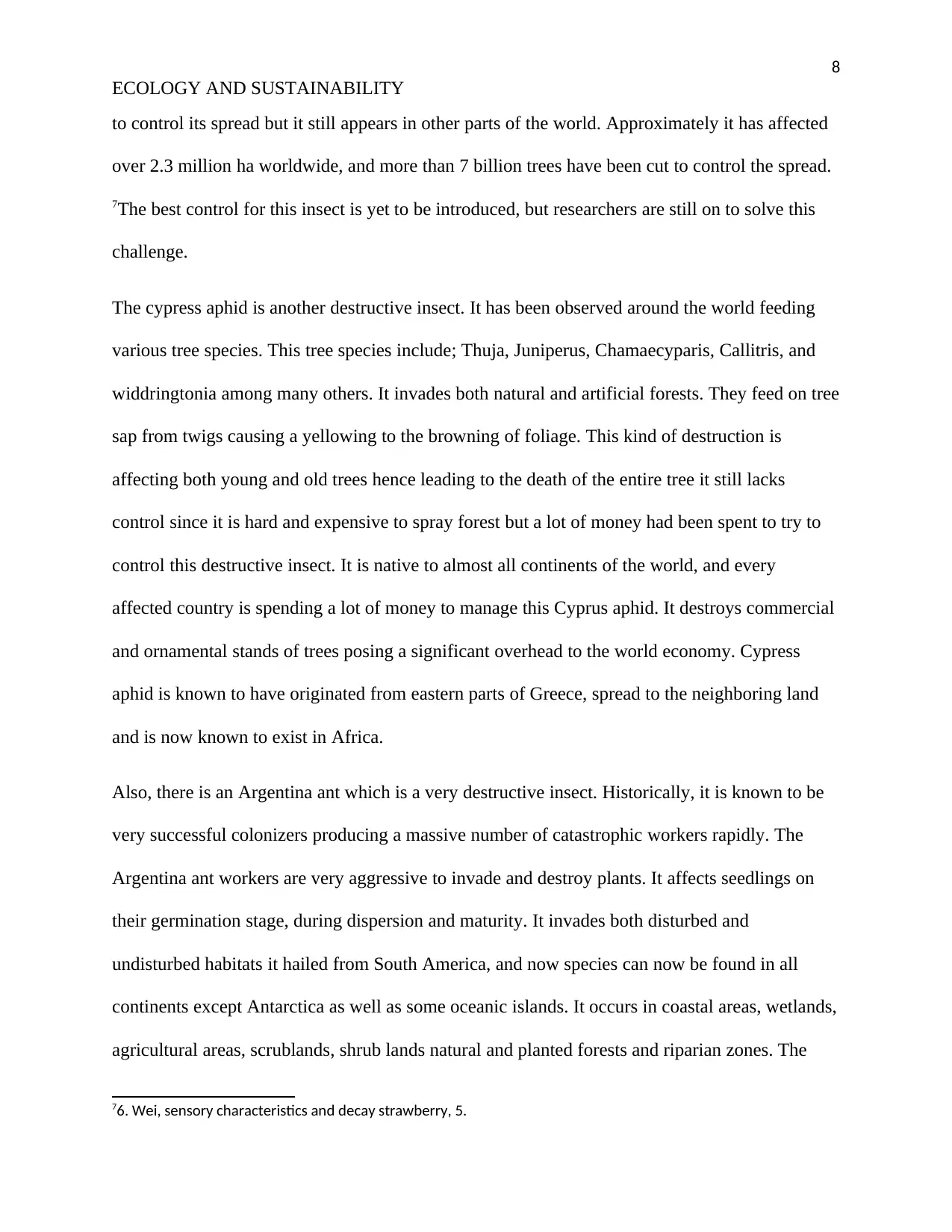
8
ECOLOGY AND SUSTAINABILITY
to control its spread but it still appears in other parts of the world. Approximately it has affected
over 2.3 million ha worldwide, and more than 7 billion trees have been cut to control the spread.
7The best control for this insect is yet to be introduced, but researchers are still on to solve this
challenge.
The cypress aphid is another destructive insect. It has been observed around the world feeding
various tree species. This tree species include; Thuja, Juniperus, Chamaecyparis, Callitris, and
widdringtonia among many others. It invades both natural and artificial forests. They feed on tree
sap from twigs causing a yellowing to the browning of foliage. This kind of destruction is
affecting both young and old trees hence leading to the death of the entire tree it still lacks
control since it is hard and expensive to spray forest but a lot of money had been spent to try to
control this destructive insect. It is native to almost all continents of the world, and every
affected country is spending a lot of money to manage this Cyprus aphid. It destroys commercial
and ornamental stands of trees posing a significant overhead to the world economy. Cypress
aphid is known to have originated from eastern parts of Greece, spread to the neighboring land
and is now known to exist in Africa.
Also, there is an Argentina ant which is a very destructive insect. Historically, it is known to be
very successful colonizers producing a massive number of catastrophic workers rapidly. The
Argentina ant workers are very aggressive to invade and destroy plants. It affects seedlings on
their germination stage, during dispersion and maturity. It invades both disturbed and
undisturbed habitats it hailed from South America, and now species can now be found in all
continents except Antarctica as well as some oceanic islands. It occurs in coastal areas, wetlands,
agricultural areas, scrublands, shrub lands natural and planted forests and riparian zones. The
76. Wei, sensory characteristics and decay strawberry, 5.
ECOLOGY AND SUSTAINABILITY
to control its spread but it still appears in other parts of the world. Approximately it has affected
over 2.3 million ha worldwide, and more than 7 billion trees have been cut to control the spread.
7The best control for this insect is yet to be introduced, but researchers are still on to solve this
challenge.
The cypress aphid is another destructive insect. It has been observed around the world feeding
various tree species. This tree species include; Thuja, Juniperus, Chamaecyparis, Callitris, and
widdringtonia among many others. It invades both natural and artificial forests. They feed on tree
sap from twigs causing a yellowing to the browning of foliage. This kind of destruction is
affecting both young and old trees hence leading to the death of the entire tree it still lacks
control since it is hard and expensive to spray forest but a lot of money had been spent to try to
control this destructive insect. It is native to almost all continents of the world, and every
affected country is spending a lot of money to manage this Cyprus aphid. It destroys commercial
and ornamental stands of trees posing a significant overhead to the world economy. Cypress
aphid is known to have originated from eastern parts of Greece, spread to the neighboring land
and is now known to exist in Africa.
Also, there is an Argentina ant which is a very destructive insect. Historically, it is known to be
very successful colonizers producing a massive number of catastrophic workers rapidly. The
Argentina ant workers are very aggressive to invade and destroy plants. It affects seedlings on
their germination stage, during dispersion and maturity. It invades both disturbed and
undisturbed habitats it hailed from South America, and now species can now be found in all
continents except Antarctica as well as some oceanic islands. It occurs in coastal areas, wetlands,
agricultural areas, scrublands, shrub lands natural and planted forests and riparian zones. The
76. Wei, sensory characteristics and decay strawberry, 5.
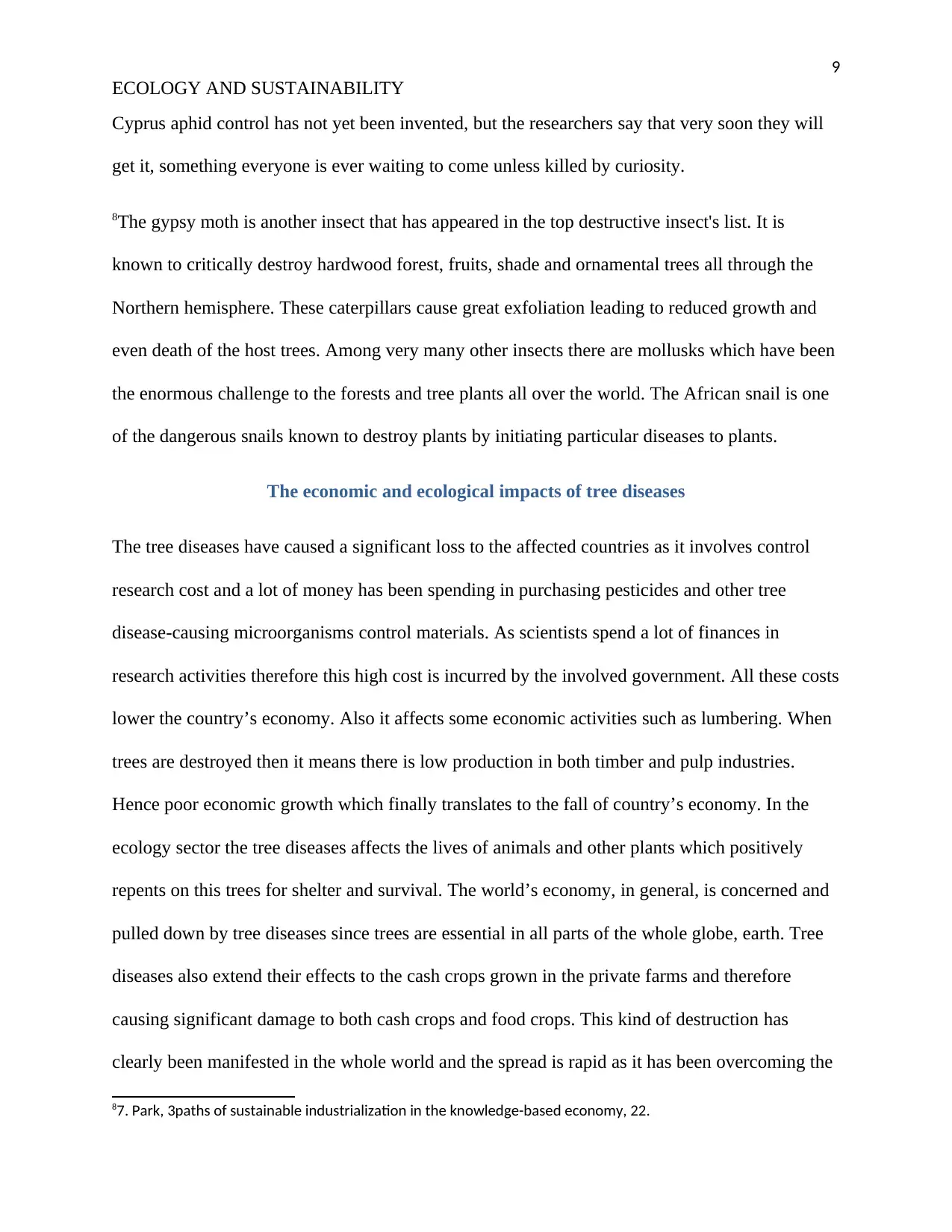
9
ECOLOGY AND SUSTAINABILITY
Cyprus aphid control has not yet been invented, but the researchers say that very soon they will
get it, something everyone is ever waiting to come unless killed by curiosity.
8The gypsy moth is another insect that has appeared in the top destructive insect's list. It is
known to critically destroy hardwood forest, fruits, shade and ornamental trees all through the
Northern hemisphere. These caterpillars cause great exfoliation leading to reduced growth and
even death of the host trees. Among very many other insects there are mollusks which have been
the enormous challenge to the forests and tree plants all over the world. The African snail is one
of the dangerous snails known to destroy plants by initiating particular diseases to plants.
The economic and ecological impacts of tree diseases
The tree diseases have caused a significant loss to the affected countries as it involves control
research cost and a lot of money has been spending in purchasing pesticides and other tree
disease-causing microorganisms control materials. As scientists spend a lot of finances in
research activities therefore this high cost is incurred by the involved government. All these costs
lower the country’s economy. Also it affects some economic activities such as lumbering. When
trees are destroyed then it means there is low production in both timber and pulp industries.
Hence poor economic growth which finally translates to the fall of country’s economy. In the
ecology sector the tree diseases affects the lives of animals and other plants which positively
repents on this trees for shelter and survival. The world’s economy, in general, is concerned and
pulled down by tree diseases since trees are essential in all parts of the whole globe, earth. Tree
diseases also extend their effects to the cash crops grown in the private farms and therefore
causing significant damage to both cash crops and food crops. This kind of destruction has
clearly been manifested in the whole world and the spread is rapid as it has been overcoming the
87. Park, 3paths of sustainable industrialization in the knowledge-based economy, 22.
ECOLOGY AND SUSTAINABILITY
Cyprus aphid control has not yet been invented, but the researchers say that very soon they will
get it, something everyone is ever waiting to come unless killed by curiosity.
8The gypsy moth is another insect that has appeared in the top destructive insect's list. It is
known to critically destroy hardwood forest, fruits, shade and ornamental trees all through the
Northern hemisphere. These caterpillars cause great exfoliation leading to reduced growth and
even death of the host trees. Among very many other insects there are mollusks which have been
the enormous challenge to the forests and tree plants all over the world. The African snail is one
of the dangerous snails known to destroy plants by initiating particular diseases to plants.
The economic and ecological impacts of tree diseases
The tree diseases have caused a significant loss to the affected countries as it involves control
research cost and a lot of money has been spending in purchasing pesticides and other tree
disease-causing microorganisms control materials. As scientists spend a lot of finances in
research activities therefore this high cost is incurred by the involved government. All these costs
lower the country’s economy. Also it affects some economic activities such as lumbering. When
trees are destroyed then it means there is low production in both timber and pulp industries.
Hence poor economic growth which finally translates to the fall of country’s economy. In the
ecology sector the tree diseases affects the lives of animals and other plants which positively
repents on this trees for shelter and survival. The world’s economy, in general, is concerned and
pulled down by tree diseases since trees are essential in all parts of the whole globe, earth. Tree
diseases also extend their effects to the cash crops grown in the private farms and therefore
causing significant damage to both cash crops and food crops. This kind of destruction has
clearly been manifested in the whole world and the spread is rapid as it has been overcoming the
87. Park, 3paths of sustainable industrialization in the knowledge-based economy, 22.
⊘ This is a preview!⊘
Do you want full access?
Subscribe today to unlock all pages.

Trusted by 1+ million students worldwide
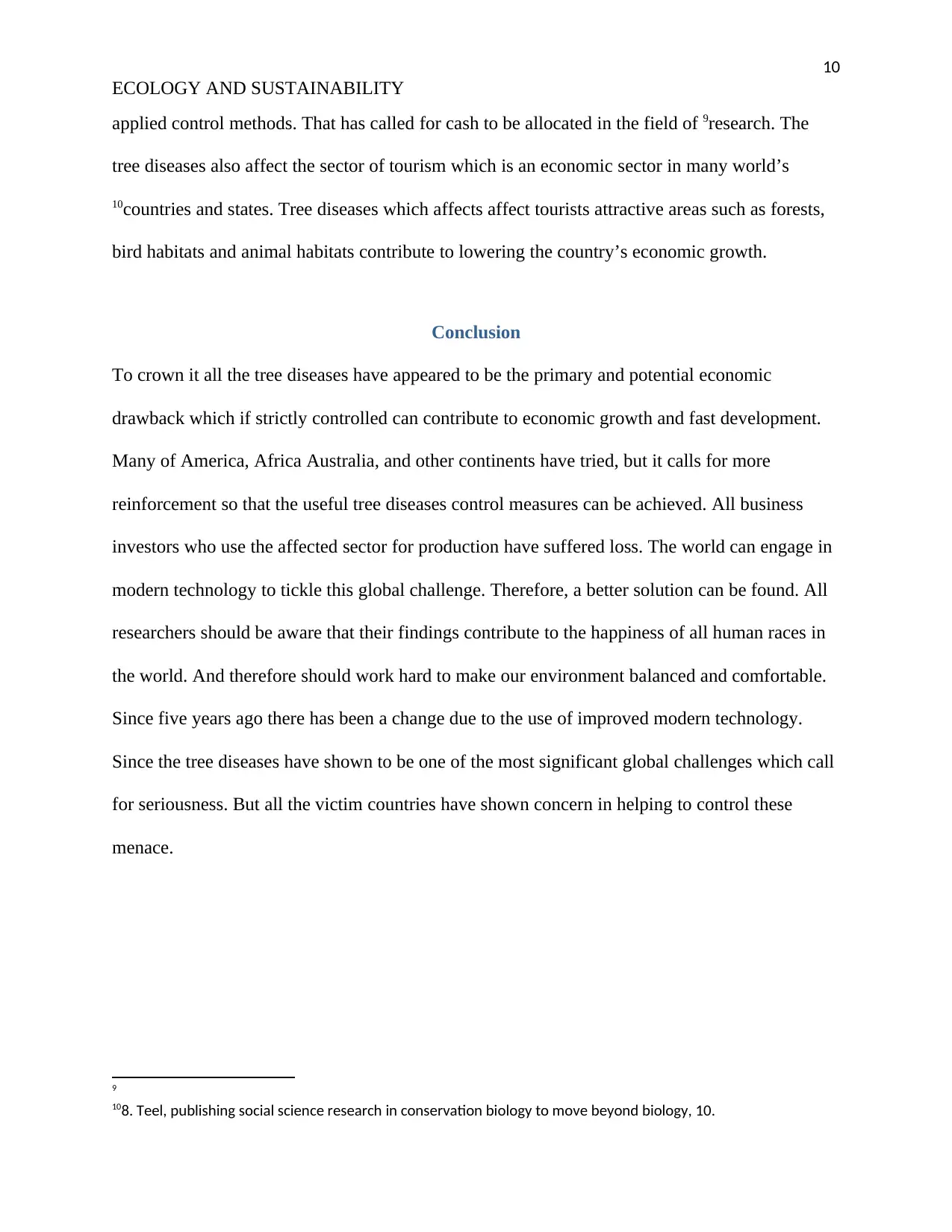
10
ECOLOGY AND SUSTAINABILITY
applied control methods. That has called for cash to be allocated in the field of 9research. The
tree diseases also affect the sector of tourism which is an economic sector in many world’s
10countries and states. Tree diseases which affects affect tourists attractive areas such as forests,
bird habitats and animal habitats contribute to lowering the country’s economic growth.
Conclusion
To crown it all the tree diseases have appeared to be the primary and potential economic
drawback which if strictly controlled can contribute to economic growth and fast development.
Many of America, Africa Australia, and other continents have tried, but it calls for more
reinforcement so that the useful tree diseases control measures can be achieved. All business
investors who use the affected sector for production have suffered loss. The world can engage in
modern technology to tickle this global challenge. Therefore, a better solution can be found. All
researchers should be aware that their findings contribute to the happiness of all human races in
the world. And therefore should work hard to make our environment balanced and comfortable.
Since five years ago there has been a change due to the use of improved modern technology.
Since the tree diseases have shown to be one of the most significant global challenges which call
for seriousness. But all the victim countries have shown concern in helping to control these
menace.
9
108. Teel, publishing social science research in conservation biology to move beyond biology, 10.
ECOLOGY AND SUSTAINABILITY
applied control methods. That has called for cash to be allocated in the field of 9research. The
tree diseases also affect the sector of tourism which is an economic sector in many world’s
10countries and states. Tree diseases which affects affect tourists attractive areas such as forests,
bird habitats and animal habitats contribute to lowering the country’s economic growth.
Conclusion
To crown it all the tree diseases have appeared to be the primary and potential economic
drawback which if strictly controlled can contribute to economic growth and fast development.
Many of America, Africa Australia, and other continents have tried, but it calls for more
reinforcement so that the useful tree diseases control measures can be achieved. All business
investors who use the affected sector for production have suffered loss. The world can engage in
modern technology to tickle this global challenge. Therefore, a better solution can be found. All
researchers should be aware that their findings contribute to the happiness of all human races in
the world. And therefore should work hard to make our environment balanced and comfortable.
Since five years ago there has been a change due to the use of improved modern technology.
Since the tree diseases have shown to be one of the most significant global challenges which call
for seriousness. But all the victim countries have shown concern in helping to control these
menace.
9
108. Teel, publishing social science research in conservation biology to move beyond biology, 10.
Paraphrase This Document
Need a fresh take? Get an instant paraphrase of this document with our AI Paraphraser
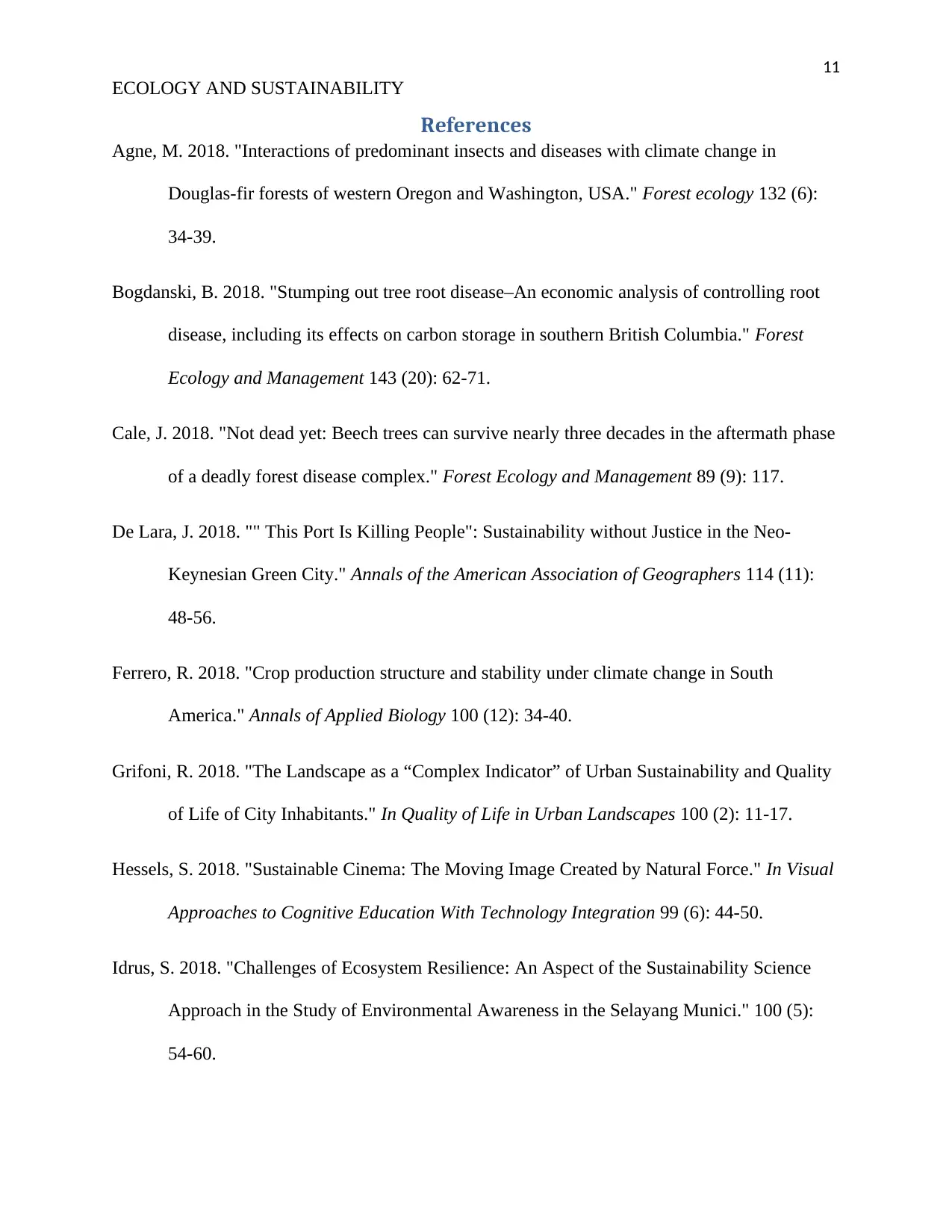
11
ECOLOGY AND SUSTAINABILITY
References
Agne, M. 2018. "Interactions of predominant insects and diseases with climate change in
Douglas-fir forests of western Oregon and Washington, USA." Forest ecology 132 (6):
34-39.
Bogdanski, B. 2018. "Stumping out tree root disease–An economic analysis of controlling root
disease, including its effects on carbon storage in southern British Columbia." Forest
Ecology and Management 143 (20): 62-71.
Cale, J. 2018. "Not dead yet: Beech trees can survive nearly three decades in the aftermath phase
of a deadly forest disease complex." Forest Ecology and Management 89 (9): 117.
De Lara, J. 2018. "" This Port Is Killing People": Sustainability without Justice in the Neo-
Keynesian Green City." Annals of the American Association of Geographers 114 (11):
48-56.
Ferrero, R. 2018. "Crop production structure and stability under climate change in South
America." Annals of Applied Biology 100 (12): 34-40.
Grifoni, R. 2018. "The Landscape as a “Complex Indicator” of Urban Sustainability and Quality
of Life of City Inhabitants." In Quality of Life in Urban Landscapes 100 (2): 11-17.
Hessels, S. 2018. "Sustainable Cinema: The Moving Image Created by Natural Force." In Visual
Approaches to Cognitive Education With Technology Integration 99 (6): 44-50.
Idrus, S. 2018. "Challenges of Ecosystem Resilience: An Aspect of the Sustainability Science
Approach in the Study of Environmental Awareness in the Selayang Munici." 100 (5):
54-60.
ECOLOGY AND SUSTAINABILITY
References
Agne, M. 2018. "Interactions of predominant insects and diseases with climate change in
Douglas-fir forests of western Oregon and Washington, USA." Forest ecology 132 (6):
34-39.
Bogdanski, B. 2018. "Stumping out tree root disease–An economic analysis of controlling root
disease, including its effects on carbon storage in southern British Columbia." Forest
Ecology and Management 143 (20): 62-71.
Cale, J. 2018. "Not dead yet: Beech trees can survive nearly three decades in the aftermath phase
of a deadly forest disease complex." Forest Ecology and Management 89 (9): 117.
De Lara, J. 2018. "" This Port Is Killing People": Sustainability without Justice in the Neo-
Keynesian Green City." Annals of the American Association of Geographers 114 (11):
48-56.
Ferrero, R. 2018. "Crop production structure and stability under climate change in South
America." Annals of Applied Biology 100 (12): 34-40.
Grifoni, R. 2018. "The Landscape as a “Complex Indicator” of Urban Sustainability and Quality
of Life of City Inhabitants." In Quality of Life in Urban Landscapes 100 (2): 11-17.
Hessels, S. 2018. "Sustainable Cinema: The Moving Image Created by Natural Force." In Visual
Approaches to Cognitive Education With Technology Integration 99 (6): 44-50.
Idrus, S. 2018. "Challenges of Ecosystem Resilience: An Aspect of the Sustainability Science
Approach in the Study of Environmental Awareness in the Selayang Munici." 100 (5):
54-60.
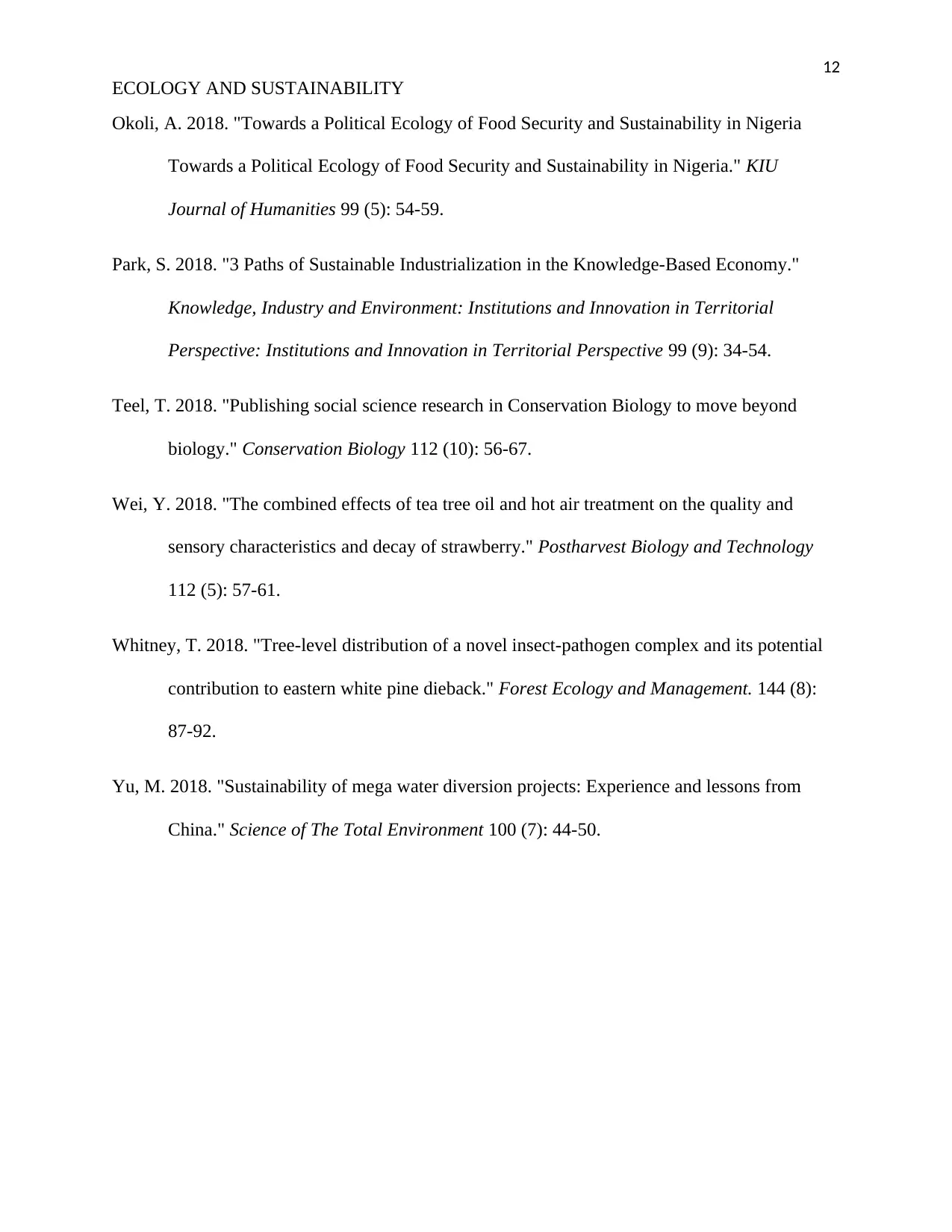
12
ECOLOGY AND SUSTAINABILITY
Okoli, A. 2018. "Towards a Political Ecology of Food Security and Sustainability in Nigeria
Towards a Political Ecology of Food Security and Sustainability in Nigeria." KIU
Journal of Humanities 99 (5): 54-59.
Park, S. 2018. "3 Paths of Sustainable Industrialization in the Knowledge-Based Economy."
Knowledge, Industry and Environment: Institutions and Innovation in Territorial
Perspective: Institutions and Innovation in Territorial Perspective 99 (9): 34-54.
Teel, T. 2018. "Publishing social science research in Conservation Biology to move beyond
biology." Conservation Biology 112 (10): 56-67.
Wei, Y. 2018. "The combined effects of tea tree oil and hot air treatment on the quality and
sensory characteristics and decay of strawberry." Postharvest Biology and Technology
112 (5): 57-61.
Whitney, T. 2018. "Tree-level distribution of a novel insect-pathogen complex and its potential
contribution to eastern white pine dieback." Forest Ecology and Management. 144 (8):
87-92.
Yu, M. 2018. "Sustainability of mega water diversion projects: Experience and lessons from
China." Science of The Total Environment 100 (7): 44-50.
ECOLOGY AND SUSTAINABILITY
Okoli, A. 2018. "Towards a Political Ecology of Food Security and Sustainability in Nigeria
Towards a Political Ecology of Food Security and Sustainability in Nigeria." KIU
Journal of Humanities 99 (5): 54-59.
Park, S. 2018. "3 Paths of Sustainable Industrialization in the Knowledge-Based Economy."
Knowledge, Industry and Environment: Institutions and Innovation in Territorial
Perspective: Institutions and Innovation in Territorial Perspective 99 (9): 34-54.
Teel, T. 2018. "Publishing social science research in Conservation Biology to move beyond
biology." Conservation Biology 112 (10): 56-67.
Wei, Y. 2018. "The combined effects of tea tree oil and hot air treatment on the quality and
sensory characteristics and decay of strawberry." Postharvest Biology and Technology
112 (5): 57-61.
Whitney, T. 2018. "Tree-level distribution of a novel insect-pathogen complex and its potential
contribution to eastern white pine dieback." Forest Ecology and Management. 144 (8):
87-92.
Yu, M. 2018. "Sustainability of mega water diversion projects: Experience and lessons from
China." Science of The Total Environment 100 (7): 44-50.
⊘ This is a preview!⊘
Do you want full access?
Subscribe today to unlock all pages.

Trusted by 1+ million students worldwide
1 out of 12
Related Documents
Your All-in-One AI-Powered Toolkit for Academic Success.
+13062052269
info@desklib.com
Available 24*7 on WhatsApp / Email
![[object Object]](/_next/static/media/star-bottom.7253800d.svg)
Unlock your academic potential
Copyright © 2020–2025 A2Z Services. All Rights Reserved. Developed and managed by ZUCOL.





